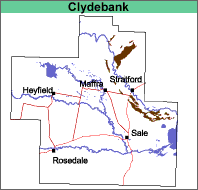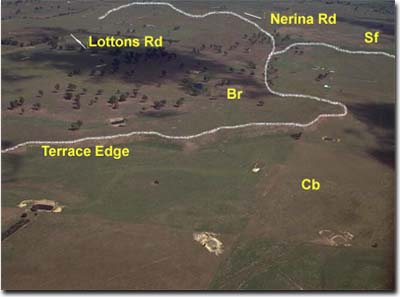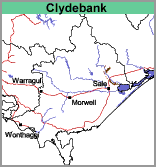Clydebank (Cb)
|
|  |
Geology
Late Pleistocene alluvial sediments.
Landform
Stagnant alluvial plain. This map unit occurs on the latest Pleistocene sediments, above the present flood plain.
 This photo shows the boundary between an earlier Pleistocene terrace (Briagolong map unit) and the latter Pleistocene terrace (Clydebank map unit). The rise at the terrace edge is clearly evident. |
It is likely that this map unit was lightly timbered with red gum.
Previous Maps and Reports
Skene and Walbran (1949) mapped the area south of the Avon River in considerable detail. The Clydebank unit from the current survey mainly comprises the following Skene and Walbran soil units: Clydebank sandy loam, Clydebank loam and Type J with minor areas of Nuntin sandy loam. The red and brown soils near Briagolong have also been included with this unit.
Ward (1977) mapped this map unit into his Bundalaguah soil association.
This map unit is included within the Sale and Nambrok and Freestone Land Systems as described by Aldrick et al. (1992).
Soils
In general the soils of the Clydebank map unit have consistently higher fine sand contents than those of the Tinamba map unit. The majority of soils have a dominantly brown loam or fine sandy loam to fine sandy clay loam surface soil. A sharp to clear change occurs at about 35 to 45 cm to dominantly red or brown light clays, usually becoming fine sandy clays to light medium clays before 1 m. The soils are generally classified as either Red Dermosols or Red Chromosols, depending on the degree of texture contrast between the surface and subsoil horizons.
Chemical and Physical Analysis
Soil Pit Site GP72 is located on this map unit and the data is provided below. Skene and Walbran (1949) provide the analyses for another three soils and one is provided by Aldrick et al. (1992). The chemical data for these soil pits show that the surface soils are generally below pH 6.0 and often below pH 5.5. The subsoils and deep subsoils are generally near neutral but the one site sampled during this survey was moderately alkaline.
GP72. Soil Pit Site (Sargeant and Imhof, 2000)
Depth cm | Texture | pH | EC dS/m | Nitrogen % | Carbon % | Ca meq % | Mg meq % | K meq % | Na meq % | H meq % | ESP % | Coarse sand % | Fine sand % | Silt % | Clay % | LAT % |
| 0-15 | FSCL | 5.1 | 0.56 | 0.18 | 2.2 | 4.0 | 1.7 | 1.3 | 0.6 | 8 | 42 | 26 | 20 | 1 | ||
| 15-30 | FSCL | 5.4 | 0.15 | 2.8 | 1.0 | 0.8 | 0.3 | 6.3 | 2 | 8 | 44 | 26 | 20 | <1 | ||
| 30-50 | FSCL | 6.9 | 0.08 | 3.5 | 2.7 | 0.2 | 0.6 | 9 | 6 | 32 | 31 | 31 | <1 | |||
| 50-90 | LMC | 7.5 | 0.16 | 5.1 | 6.8 | 0.3 | 1.7 | 13 | 3 | 15 | 31 | 49 | 1 | |||
| 90-120 | MC | 8.6 | 0.23 | 4.6 | 6.9 | 0.2 | 3.2 | 22 | ||||||||
| 120+ | LC | 8.8 | 0.35 | <0.1 | 4.4 | 0.2 | 3.1 | 40 |
Clydebank sandy loam, (Skene and Walbran, 1949)
Depth cm | Texture | pH | EC dS/m | Cl % | Nitrogen % | Carbon % | Coarse sand % | Fine sand % | Silt % | Clay % | LAT % |
0-18 | SL | 5.6 | 0.08 | .007 | 0.140 | 1.61 | 11 | 57 | 17 | 10 | 1 |
18-41 | S | 6.1 | 0.05 | .005 | 12 | 60 | 16 | 9 | 2 | ||
41-48 | SCL | 6.1 | 0.07 | .006 | 6 | 60 | 14 | 18 | 1 | ||
48-64 | SC | 5.5 | 0.11 | .016 | 4 | 54 | 13 | 26 | 1 | ||
64-81 | SC | 5.6 | 0.09 | .010 | 2 | 59 | 11 | 24 | 1 | ||
81-91 | SCL | 5.8 | 0.10 | .011 | 2 | 57 | 14 | 23 | 1 |
Clydebank loam, (Skene and Walbran, 1949)
Depth cm | Texture | pH | EC dS/m | Cl % | Nitrogen % | Carbon % | Ca meq % | Mg meq % | K meq % | Na meq % | Coarse sand % | Fine sand % | Silt % | Clay % | LAT % |
0-20 | L | 5.3 | 0.07 | .006 | 0.140 | 1.54 | 2.8 | 0.9 | 0.5 | 0.1 | 12 | 51 | 14 | 17 | 1 |
20-36 | FSL | 6.1 | 0.06 | .006 | 13 | 54 | 13 | 16 | 1 | ||||||
36-46 | FSL | 7.1 | 0.06 | .008 | 14 | 54 | 3 | 17 | 1 | ||||||
46-53 | SC | 6.8 | 0.10 | .012 | 15 | 50 | 11 | 21 | 1 | ||||||
53-69 | SC | 6.6 | 0.15 | .020 | 20 | 40 | 11 | 26 | 2 | ||||||
69-107 | LC | 6.2 | 0.25 | .037 | 8 | 27 | 24 | 36 | 2 | ||||||
112-152 | FSC | 8.0 | 0.24 | .037 | 7 | 36 | 27 | 26 | 2 |
Clydebank clay loam, (Skene and Walbran, 1949)
Depth cm | Texture | pH | EC dS/m | Cl % | Nitrogen % | Carbon % | Ca meq % | Mg meq % | K meq % | Na meq % | Coarse sand % | Fine sand % | Silt % | Clay % | LAT % |
0-23 | CL | 5.7 | 0.06 | .004 | 0.204 | 2.55 | 6.2 | 2.0 | 0.3 | 0.2 | 9 | 38 | 28 | 19 | 1 |
23-36 | CL | 6.4 | 0.05 | .004 | 11 | 39 | 28 | 20 | 1 | ||||||
36-46 | CL | 6.9 | 0.04 | .005 | 11 | 37 | 28 | 21 | 1 | ||||||
46-53 | CL | 6.6 | 0.07 | .006 | 11 | 31 | 23 | 29 | 1 | ||||||
53-76 | LC | 6.5 | 0.07 | .008 | 3.5 | 5.4 | 0.2 | 0.4 | 2 | 31 | 28 | 35 | 1 | ||
76-127 | FSC | 6.7 | 0.08 | .012 | 3 | 43 | 25 | 25 | 1 |
Profile 57, Briagolong 1, (Aldrick et al., 1992)
Depth cm | Texture | pH | EC dS/m | Cl % | Nitrogen % | Carbon % | Ca meq % | Mg meq % | K meq % | Na meq % | H meq % | ESP % | Coarse sand % | Fine sand % | Silt % | Clay % |
0-10 | FSL | 5.1 | 0.05 | .005 | 0.21 | 2.07 | 1.9 | 0.8 | 0.9 | 0.1 | 9.4 | 1 | 5 | 46 | 25 | 20 |
12-20 | FSL | 5.6 | 0.03 | .002 | 0.10 | 0.90 | 2.8 | 1.1 | 0.7 | 0.1 | 5.0 | 1 | 4 | 47 | 28 | 21 |
30-42 | FSCL | 6.2 | 0.02 | .002 | 2.7 | 1.5 | 0.7 | 0.1 | 2.9 | 1 | 4 | 40 | 30 | 25 | ||
60-80 | LC | 6.3 | 0.04 | .002 | 4.7 | 3.8 | 0.5 | 0.5 | 6.6 | 3 | 1 | 26 | 34 | 41 | ||
90-120 | FSL | 6.5 | 0.03 | .003 | 2.9 | 2.9 | 0.2 | 0.5 | 3.8 | 5 | 6 | 45 | 27 | 23 |
The following abbreviations are used to describe field texture: S - sand; LS - loamy sand; ClS - clayey sand; SL - sandy loam; L - loam; CL - clay loam; SCL - sandy clay loam; SC - sandy clay; FSCL - fine sandy clay loam; FSC - fine sandy clay; LC - light clay; MC - medium clay; HC - heavy clay; GR - gravel; ZL - silty loam; ZCL - silty clay loam; ZLC - silty light clay; ZMC - silty medium clay.
Particle size distribution data given for Skene and Walbran (1948, 1949) does not include the water content of the soil. As a result the coarse sand, fine sand, silt, clay and loss on acid treatment (LAT) may not add up to 100%. Aldrick et al. (1992) does not provide LAT data.
Other symbols include: pH - analysed in water; EC - electrical conductivity; Cl - chloride; Ca - exchangeable calcium; Mg - exchangeable magnesium, K - exchangeable potassium; Na - exchangeable sodium; H - exchangeable hydrogen; ESP - exchangeable sodium percentage.
For Soil Pit Sites (Sargeant and Imhof, 2000) exchangeable cations have been determined using Gilman method (where pH >7) and Tucker method (pH <7). Exchangeable Sodium % (ESP) has been calculated here as the percentage of sodium in relation to the sum of the exchangeable basic cations.
Land Use
The soils of this map unit have always been regarded as ideally suited for irrigated permanent pastures and irrigated lucerne. Skene and Walbran (1948) note that the uneven topography of the landscape is the main handicap to irrigation lay out. Over-watering of the soils in this map unit has long been recognised and it is likely that spray irrigation will afford the best water control.



